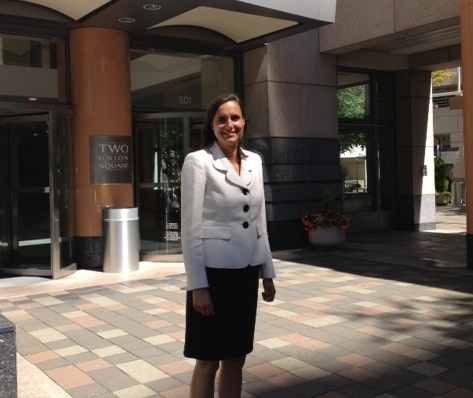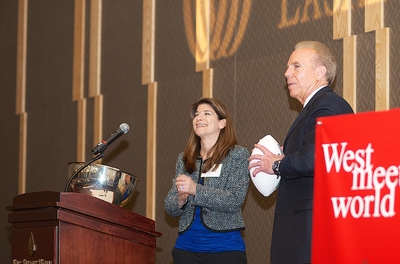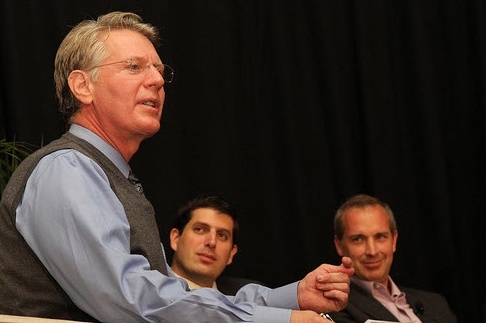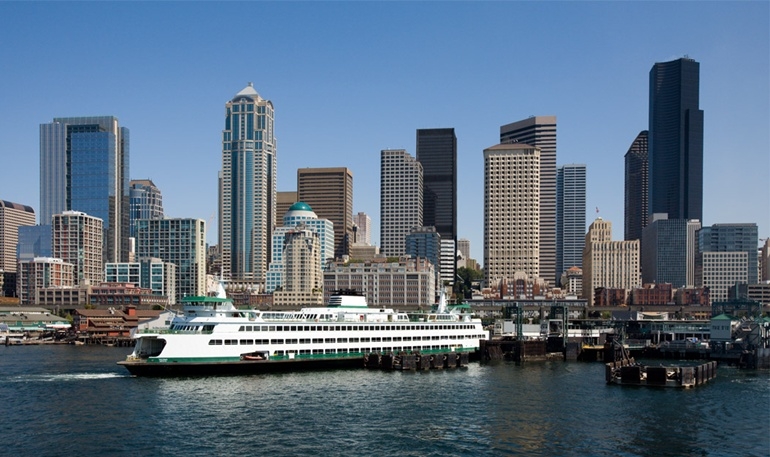|
How can Seattle office buildings compete for new tenants? Be cool, JLL managing director Laura Ford tells us. (Oh man, that was the same advice we got in high school and we failed pretty badly.)  Seattle's in the midst of a fairly tight employment market, with tech/creative and professional services firms all competing aggressively for the Millennial employee, Laura explains. This has meant that buildings--whether they're in the on the skyline or not--have to offer a fresh, vital look and highly amenitized environments. (In- office magician?) The cool factor, if you will, in order to win new tenant interest, she says.  Cool core buildings also attract investor interest. According to JLL's latest research, Seattle saw the 8th largest sales transaction rate in the nation in trophy and Class-A office, and rent growth among newly traded properties has been significant. Such Seattle buildings that have traded since 2011 have an asking rate of $38.27/SF, a premium of 6.8% above the trophy and Class-A asking rates nationwide. JLL managing director Lori Hill (snapped recently with Roger Staubach) tells us that Seattle now counts as a tier-one gateway market for institutional investors, who're still looking for high-profile core properties. Seattle offers them that. |
 |
Public Policy Struggles to Keep Up With Seattle BoomThe Puget Sound area is going to see population and job growth for the foreseeable future--decades into the future, including urban downtowns as well as the suburbs--says Cairncross & Hempelmann attorney Nancy Rogers, who moderated both panels at Bisnow's recent Seattle Construction & Development Summit. (And as we all grow older and the population grows, the grocery store line wait is going to skyrocket.) The region's growth, she tells us, is driving public policy trends that will affect developers and property owners. The Seattle area can't simply sprawl, both for geographic reasons and because the Growth Management Act determines what will be at urban density, and what won't. The GMA is going to continue to drive density in areas in which density is allowed, and that's going to continue to drive up prices as land supply becomes more constrained.  At the state level, Nancy says that it's tough to know when a comprehensive transportation policy is finally going to emerge from the state legislature--though one needs to, and the sooner the better. “We need improved transportation infrastructure,” she says. “It's vital to serve existing businesses, and allow new businesses to grow.” (Tandem bikes just aren't going to be a viable transportation options, regardless of what the Muppets might have you believe.) So far the state hasn't stepped up to the plate to pass a transportation package. There's still a lot of disagreement in Olympia about how state-run projects should be permitted and run, among a number of other sticking points. Nancy's snapped at home on her deck, which just happens to have a terrific view of downtown. |
 |
Hammer & Hand's Hold on RestaurantsDaniel Thomas is not only the CEO of Seattle/Portland-based construction company Hammer & Hand—he's also the co-owner of a hopping new restaurant in Portland called Xico. As a result, he brings a unique perspective to Hammer & Hand's restaurant construction work, including the firm's yet-to-be-disclosed new project in South Seattle. Among the restaurant trends Daniel sees is consumers' increasing demand for authenticity and unique experiences. This means a proliferation of new equipment and kitchen requirements, from open-hearth cooking to new bar equipment for the craft cocktail movement. In front of the house, there's a need to break the mold and create inviting, interesting, and beautiful spaces. For more info on our sponsor, click here. |
 |
 |
Bisnow's World-Class Restaurateurs |
||
|
This morning, 250 real estate pros joined us at the Triple Door for Bisnow's Seattle Restaurant Development Summit to hear top restaurateurs and developers (and a top architect, broker, and lawyer) describe and debate the trends and needs are of the industry. But all agreed the dining scene is infusing huge new life into urban Seattle and helping create or revitalize whole new neighborhoods. Of course, holding the event in the venue of a glamorous music venue made us feel like we were living the life just listening. You'll find full coverage in the next edition of Bisnow Seattle. |
On hand: celebrity chefs and restaurateurs Tom Douglas, Matt Dillon, Renee Erickson, Thierry Rautureau, Ethan Stowell, and Rick Yoder. Also, restaurant developers Matt Griffin and Patrick Foley, restaurant broker Laura Miller of Gibraltar, restaurant lawyer Sandip Soli of Cairncross Hempelmann, architect and NBBJ chief Scott Wyatt, and Washington State Restaurant Association CEO Anthony Anton. Thanks also to great GC Hammer and Hand for helping us put on the event; and to all of you who came, so devoted to hearing about food, you didn't mind that it was breakfast, not your usual designer dinner. |
|
 |
Cities Need to Get Smart |
||
 Smart Cities Council chairman Jesse Berst, who lives in Bellevue, tell us that Seattle's pretty smart, but it could be a lot smarter. Seattle has a fine collection of individual properties with labels like "green," "sustainable" and "energy-efficient," he says, but it isn't yet considering how to integrate these individual islands of innovation into a complete picture. “Nor is the city fully committed yet to sharing infrastructure and costs between departments,” he explains. “Cities who take a holistic approach typically find they can cut 20% to 30% from their budgets by eliminating duplication and redundancy.” |
 Smart Cities Council is an industry coalition to advance smart city development. It recently held a major meeting in DC (they just missed the Cherry Blossom Festival), and Jesse tells us that one of the main takeaways is to think big, but start small. With the help of digital technology and willing citizens, cities like Seattle can achieve greater health, happiness, and prosperity, he says, but it's important to start small. “Pick a project that has a small upfront investment, a quick turnaround, and a rapid payback,” he says, adding that ideally, this first target will be a consensus priority, something that is near the top of the list for key stakeholder groups. |
|
 |





